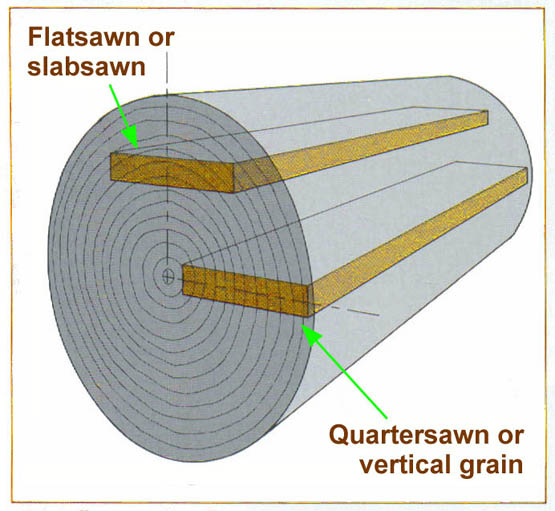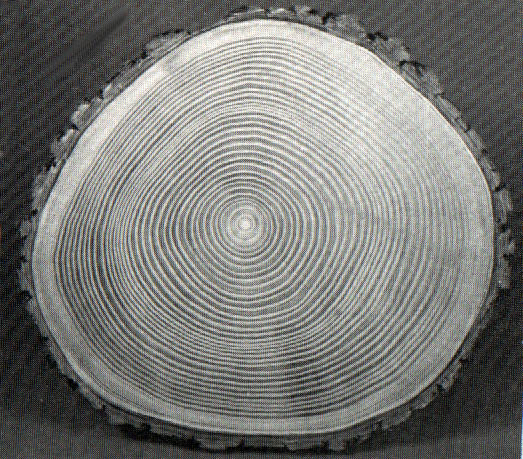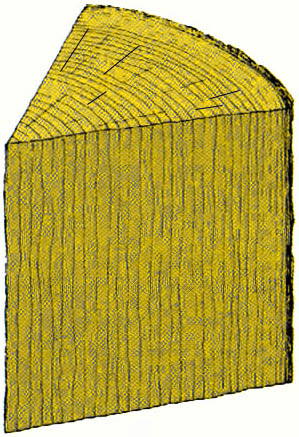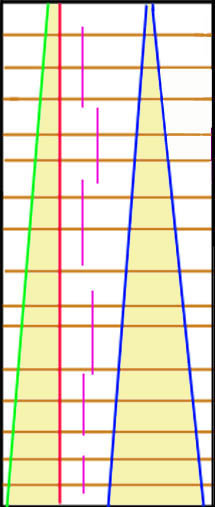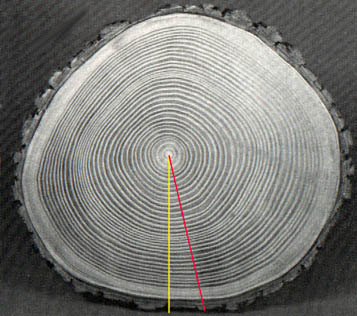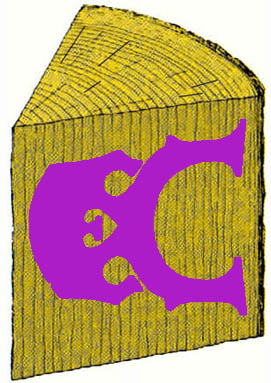| Subject:
Bridge grain orientation
Hi Paul
Medullary rays always radiate from the center of the tree towards the outside, always at right angles to the annular rings. They appear in this sketch on the endgrain, on the top:
From R. Bruce
Hoadley's Understanding Wood
If you look at an idealized hunk of maple from the endgrain, as in the sketch below, you see the annular rings (tan, horizontal) and the meds (fuchsia, vertical). There are two bridge possibilities here: 1) the red/green bridge is typical. The red face, being parallel with the meds, will show them well. This is the "good" side. The green face, being not aligned so well, will show them less. 2) the "blue" bridge will show no good meds on either face, because neither face aligns with the meds. It only has to be a tiny bit off and it's "no show.".
Here's a way a bridge with meds on both faces could theoretically happen:
The two colored lines each follow the path from the center to the edge, at right angles to the annular rings. Therefore, being each parallel with the radial medullaries, each face has the potential for having a good display of those meds. This is why I said in my TOBI post that the bridge would be located within the trunk with its feet to the outside of the tree - to maximize that wedge. Given the proper perfect wedge, you might get two equally good faces. In actual practice, it probably happens both ways - whatever way a piece of maple can best be used. Wood is not that consistent.
Here's how a bridge fits into the grain of a tree. If you look at dozens of bridges, you'll note that some only show spiegel on part of that "good" surface, because the grain of the wood wasn't perfectly flat, or possibly just because the meds weren't that prominent in the first place. Some maple shows huge meds, others very tiny ones. Platanus (New World sycamore) has enormous, sensational meds, like Australian lacewood. Oak can have really beautiful ones, which is why quarter-sawn oak is so highly prized. Some woods have little to show, like birch, alder, basswood, et al. Ed Campbell taught, when I was there in 1991, that the luthier should place the face with most prominent medullary rays toward the player if I recall it correctly. Does it matter which way the faces are oriented? From a practical standpoint it makes no difference whatsoever. It's not stronger, or less prone to warping forward. Having the pretty side of the bridge face the player is just a custom, an aesthetic touch. I do that, and generally don't leave (or even have to begin with) a brand-name stamp on the bridge. Like most luthiers, I put my own name stamp on the side of the bridge facing away from the player. I also only put that stamp on high-end bridges. Do manufacturers always put their "brand" on one face or the other, or is it a hit or miss thing? Usually they put their stamp on the pretty
side, for it obviously helps advertise their product to the player, who
sees it each time the instrument gets played. If it's on a bad side, it's
usually a mistake.
Any more questions?
Drop
me a line
click
here
|
